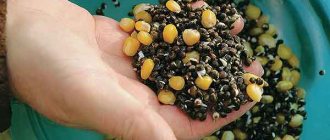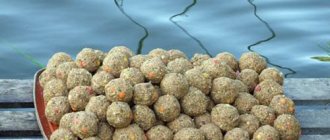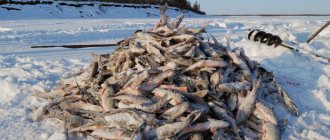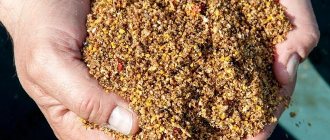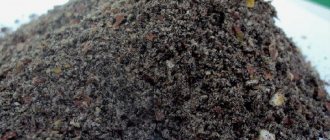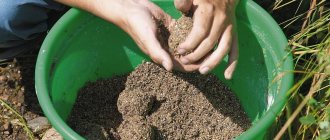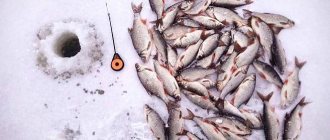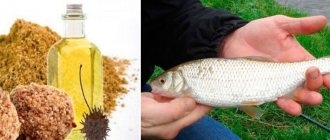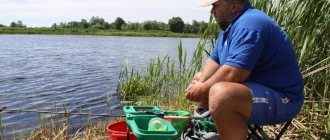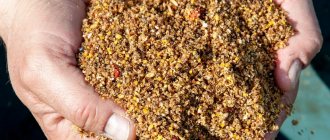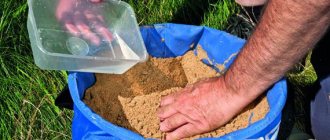Commercial bait for trout
It's no secret that most fishermen prefer purchased bait, despite the fact that they have to spend a lot of money.
Although, it should be noted that purchased bait for trout is cheaper than homemade bait. This is the paradox. Despite this, it is noted that homemade bait is more effective than store-bought bait. This is also a kind of paradox. Therefore, each of the fishermen has the right to dwell on any of the paradoxes. For baiting trout, they developed a special bait called “ pellets ”. It is sold in any fishing store, along with bait for bream, crucian carp, etc.
It's no secret that most fishermen prefer purchased bait, despite the fact that they have to spend a lot of money. Although, it should be noted that purchased bait for trout is cheaper than homemade bait. This is the paradox. Despite this, it is noted that homemade bait is more effective than store-bought bait. This is also a kind of paradox. Therefore, each of the fishermen has the right to dwell on any of the paradoxes.
Trout food main features
To prepare food for trout, you need to know the biological characteristics of this commercial fish. In trout farming, the quantity and suitability of feed used determines the profitability of production.
Trout and other salmonids can efficiently consume foods that contain primarily protein (mostly from fish) and can obtain some of their energy from fats and, to a lesser extent, carbohydrates.
- Trout food: protein, fat content
- Trout feed quality
- Trout feeding practice
- The effect of water temperature on trout food
- How to feed trout
- Automated trout feeding
- Trout feeding temperature
Food for trout, namely adult fish, usually contains from 38 to 45 percent protein and from 10 to 18 percent fat. Switching to lower protein compositions usually occurs when moving from a kibble feed to a pelleted diet, called a plant-based or production diet.
Pond cultivation technology - how to breed
The pond can be either natural or artificial. For a natural one, the reservoir will have to be prepared to receive fry. In this case, it is necessary to do high-quality cleaning, preparing for stocking. It is worth noting that there are many problems with this type of breeding site - not only in terms of preparation, but also simply in creating the most optimal living conditions, as well as in the fight against poachers. In general, you will need to organize an artificial reservoir:
- Pump systems;
- Water filtration system;
- Feed supply.
Therefore, it is recommended to create an artificial pond. To do this, either take a plastic bowl or make a corresponding base in the ground. The cage option for breeding is unacceptable. You can also prepare a pool for this. The pool will require the same equipment, but with the corresponding indicators.
It is necessary to select equipment according to the displacement that it is capable of processing. Ideally, the indicators should be slightly higher so that the elements do not wear out too quickly when operating at the limit.
Trout prefers live food. The fry do not mind swallowing squid larvae, flies, dragonflies, and beetles. As they grow older, they can switch to smaller types of fish. This can be found either from fishing store suppliers or from farming businesses. There are:
Additional recommendations
Today, trout are bred, as a rule, in swimming pools, natural reservoirs and in special systems created artificially. It is important that the fish receive a balanced diet. This directly affects the speed of its development. Trout is a predator. Special feed mixtures are used for her. They definitely contain carotene. It is noteworthy that initially the meat of this fish does not have a reddish tint - it is this element that colors it.
As a rule, food is used wet or dry. Granular is popular among breeders. To gain 1 kg of fish weight, about 2 kg of dry food is required. If we are talking about wet food, about 6 kg is required. Moreover, even effective feeding does not bring much results if there are no suitable circumstances. It is necessary that the water has a sufficient concentration of oxygen.
Typically, imported feed costs about $2 per 1 kg. About a day, one adult eats food in the amount of 10% of its body weight. However, this indicator is directly influenced by the conditions of its detention. Contrary to popular belief, it is dangerous to feed trout too much food. This may cause her growth to slow down. It is most profitable to breed one-year-old fish whose weight exceeds 250 g. Young fish need to be fed about seven times a day, and adults - no more than 4 times a day.
It is worth considering that this fish adapts very well to various conditions. Depending on the environment, it can change its color. Not only in different waters, but also in the same stream, you can find fish that differ in color from others. Trout are often raised in artificial reservoirs because only about 10% of the fry survive in the natural environment.
Reproduction in the natural environment occurs in the spring, but in fish farms it can occur all year round.
To select food, it is necessary to take into account the conditions in which this type of fish is bred. It is recommended to use fish meal (up to 50% of the diet), as well as milk (skimmed, dry), blood or bone meal. Trout should consume a lot of protein, especially juveniles. In blood meal, this component is not completely complete, which breeders need to take into account.
In addition, you can add cake and meal (flaxseed, sunflower, etc.) to fish feed. However, it is not recommended to give her cotton meal due to the presence of toxic impurities in it. It is imperative to add feed yeast to the diet, which is a source of many vitamins.
Bait for trout
If you like to fish for trout, then you have probably thought about the question: “Is it worth feeding trout?”, or, as a last resort: “What bait should I use for trout?” The answer is simple - trout should definitely be fed in 3 cases:
- when fishing on a feeder with a feeder;
- when fishing with a float rod;
- when fishing from ice.
When fishing for trout using a spinning rod, bait does not matter at all. The spinning angler’s task is to examine each section of the reservoir and the water horizon for the presence of fish, as well as select a catchable bait. Therefore, this method of fishing does not interest us now. But if you are going to catch trout with a float or donk, then this article is just for you.
Most often, the best results are shown by pellets with a fish scent, but it happens that trout prefer some other flavor, so it is best to have several bait options with you.
Bait for trout in autumn
Fishing for trout on a feeder in the fall will be successful if you also choose bait for trout. Bait is necessary to more actively attract fish to the fishing site, and if you take into account what is caught using a feeder, then with each new cast it is necessary to send a new portion.
If a fisherman is planning to catch trout on a feeder in the fall, then he needs to be extremely patient and worry about his convenience in advance. For feeder fishing, baits such as maggots, worms, bloodworms and others are used.
The main thing to remember is that it is not so much the bait that is important as the accuracy of casting, and this requires a lot of skill.
The main thing to remember is that it is not so much the bait that is important as the accuracy of casting, and this requires a lot of skill.
Types of pond trout
There are 20 varieties in the world, but 2 species are grown at home, each of which is characterized by special preferences for living conditions. All of them are predators and require financial investments in food, as they eat only high-quality food.
REFERENCE! How much money will it take in the end and how expensive is it? For comparison, an open pond method for a small fish farm with a production of 4 tons per year costs an investment of 1.5 million rubles, and a RAS with an annual turnover of 10 tons of products is estimated at 3.5 million rubles or more.
The most common nozzle
Trout paste from the manufacturer Berkley has the best combination of price and quality
The most common and frequently used bait is trout paste. It is popular because when used, the catch will be good throughout the year. Despite the fact that the pasta is quite cheap, some fishermen try to prepare it themselves. For preparation, dough and aromatic additives are used. Berkley - considered one of the best pastes. It contains: a concentrated protein mixture and a strong flavor. The most effective, as fishermen's practice has shown, is cheese, caviar and garlic paste. But there are two mandatory rules when working with paste.
Read Lead material for pike
How to choose a spoon for trout
The first thing is that the paste should never be frozen, otherwise it will lose its properties. The second rule is that you cannot skimp on pasta. Trout eats quite a lot and therefore there should be a lot of paste too. Trout paste is recommended for deep-sea fishing. You need to take a forty gram weight and tie it to the end of the main fishing line, then tie a leash after forty centimeters. The length of the leash, with a hook tied at the end, should be about fifty centimeters. Before casting, a large cherry is molded from the paste and placed on the hook.
The fishing rod is much more convenient for this type of fishing. Using paste molds, a figure is made, which is then placed on a hook. The bait should be lowered into the water about one meter.
Feeding trout
To feed trout, products of animal origin are needed: meat, fish, etc.
Among feeds of animal origin, farms mainly use slaughterhouse waste, fish, meat and bone and blood meal, silkworm pupae, fresh and frozen fish, etc.
For different age groups of trout, the following food is used: for larvae - live zooplankton, egg yolk, blood tissue of the spleen, pressed through a mill sieve or gauze. To feed the fry, the mixture is prepared in the form of a dough-like mass, which includes the following components: blood tissue of the spleen (85%), meat-bone and meat-fish meal (14%) and fat (1%).
To feed trout, wet and dry food is used. Dry food in the form of granules is widely used in trout farms. They have a number of advantages compared to dough-like mixtures. The granules can withstand long-term storage (up to 1 year); they can be dosed more accurately using mechanization during distribution.
In the first days of feeding, food is given at least 10 times a day.
For juveniles weighing 0.5-0.8 g, the following diet is recommended, %:
- beef spleen – 60,
- fishmeal – 25,
- phosphatides-5,
- feed yeast – 10;
upon reaching body weight 1 g or more, %:
- beef spleen – 50,
- fishmeal – 30,
- meat and bone meal – 5,
- phosphatides – 5,
- feed yeast – 10.
For fingerlings weighing 3-15 g, use granulated food according to the RGM-2M recipe, %:
- fishmeal – 4.6,
- meat and bone – 9,
- blood – 5,
- wheat – 11,
- algal – 1,
- hay – 2,
- dry return – 9,
- hydrolytic yeast – 4,
- soybean meal (flour) – 6,
- Sunflower meal (flour) – 2,
- fish oil (vegetable oil) – 4,
- premix – 1.
Food is given to the fish 6-8 times a day.
To feed yearlings, use a dough-like mixture of the following composition, %:
- beef spleen – 50,
- meat and bone meal – 10,
- flour from silkworm pupae – 5,
- fishmeal – 5,
- flour from grain waste – 12,
- phosphatides – 10,
- feed yeast – 5,
- fish oil – 1,
- table salt,
- premix – 1.
How to make bait for carp
The simplest carp bait recipe consists of only 3 components and looks like this:
- breadcrumbs;
- crushed oatmeal cookies;
- sunflower cake.
All components are mixed in equal proportions and moistened. You can add a sweet flavor to the carp feeding mixture.
The other recipe is more complex and includes:
- 1 kg corn flour;
- 200 gr. hemp cake;
- 300 gr. sunflower cake;
- 200 gr. chopped hazelnuts;
- 1 can of corn;
- 200 ml molasses.
The dry ingredients are thoroughly mixed together and moistened with water in which honey was previously diluted. The corn is added at the very end. A bait mixture that shows good results on large rivers consists of several components:
- 1 kg breadcrumbs;
- 1 kg of wheat bran;
- 300 gr. hemp seeds;
- 300 gr. sunflower cake;
- 500 gr. boiled millet;
- 300 gr. oatmeal
At the end of the moistening procedure, soil and dry flavoring are added to the bait. If a liquid activator is used, it is added to the water before mixing.
In paid reservoirs, fish are taught to eat specialized feed, which must be included in the mixture. Privada for the “payer” includes:
- 1 kg of fish feed;
- 1 kg rye bran;
- 500 gr. sunflower cake;
- 300 gr. ground hemp seeds;
- 300 gr. ground peanuts;
- sweet flavoring.
The fish feed is first poured with boiling water and infused for 5–6 hours. After the compound feed has infused, other ingredients are poured into it. If necessary, you can additionally moisten the bait by adding flavoring to it. The most complex recipe used to lure finicky fish is:
Read Lead material for pike- 1 kg of corn grits;
- 1 kg biscuit ground crackers;
- 300 gr. powdered milk or baby food;
- 300 gr. hemp seeds;
- 300 gr. chopped peanuts;
- 200 gr. chopped hazelnuts;
- 300 gr. coconut cake;
- 300 ml molasses.
After mixing the dry ingredients, the bait is moistened with water with molasses diluted in it. If necessary, a sweet activator is added.
Feeding trout
The main work process in trout farming is feeding. It accounts for 50-60% of production costs. Feeding should not be limited to just giving food to fish without taking into account changing conditions: trout growth, food quality, thermal and gas regimes of water in pools, cages and ponds. Only clear, constant control over feeding technology makes it possible to obtain an economic effect when growing trout.
Complete feeds produced by industry are the main food for trout. Dry feed is produced in the form of grits and granules of different sizes. As fish move from one size group to another, the size of the grits and pellets fed changes. Kruplets measuring 0.4-2.5 mm are used to feed juvenile trout weighing up to 5 g. Granules with a diameter of 3.2-10 mm are made for feeding trout weighing from 5 g to 1 kg or more (Table 81).
Along with the use of dry granular feed in feeding trout, paste-like feed is used, based on products of animal origin (beef spleen, fresh inedible fish) with the addition of bran, cake, meal and yeast. This food is much cheaper, but does not last long. It is usually used for feeding trout in small farms or when raising larvae in a hatchery.
Do-it-yourself trout feed
Many people would like to have a pond, even a small one, in their suburban area. A small pond can not only create a wonderful microclimate right next to the house and diversify the landscape. Very often it also becomes a source of income. All you need to do is set up a fish pond. This is not a very simple task, but if you have the desire and certain knowledge, it is quite doable.
Where to begin?
First of all, you should decide on the shape and size of the future pond. If desired, you can arrange it round, square, oval, etc. water. Success in a business like fish farming depends not on the shape, but on the size of the pond. It should be borne in mind that the option smaller than one meter and already ten in this case is completely unacceptable. The larger the reservoir, the faster the young animals will grow in it and the easier it will be to care for them. The best option is a fish pond with a size of approximately 25–50 m2.
Pond construction. Basic Rules
When constructing a reservoir, it is necessary to follow some recommendations from experienced fish farmers. This will make the growing process much more efficient. Success in fish farming is guaranteed only if a number of conditions are met.
- Correctly selected soil for the bottom of the reservoir.
- The bottom has a complex terrain. Shallow water areas should alternate with deep water areas.
- The location for the reservoir itself has been chosen correctly.
How to choose the right place
A pond for breeding fish should definitely be built in open areas. In this case, it is best if during the day one part of it is illuminated and the other is in the shade. It is also very important to ensure that shrubs and trees do not grow in the immediate vicinity of the reservoir. The fact is that their roots, penetrating into the water, will certainly begin to cause rotting processes, which will negatively affect the fish’s weight gain. In addition, rotting leaves constantly floating on the surface of the water will not decorate the pond in any way.
When choosing a location for a future pond, it is also necessary to take into account such an important point as the possibility of supplying electricity. It is useful for aeration in winter.
Types of fish ponds
So, you have decided where you should build a pond. Breeding fish in it will be successful only if you take into account all the above recommendations. Now you need to decide what kind of reservoir it will be. Today, there are several types of ponds suitable for fish farming.
- With concrete base. The construction of such a reservoir is somewhat labor intensive. However, the result obtained will be guaranteed to last.
- Plastic pond. It is mainly suitable only for breeding ornamental fish, since the size of such a reservoir is limited.
- Pond constructed using PVC film. It can have any shape and be quite large in size. However, the service life of the film is limited to 10 years.
- Unlined pond. This option is ideal for an area with a high groundwater level. In this case, the bottom and walls are coated with clay and covered with turf.
Most often, a concrete fish pond is installed on a summer cottage.
Construction of a concrete pond in stages
In the selected location, mark the contours of the future reservoir using pegs and a cord. Next, they begin to excavate the soil to the required depth (the depth of the pond plus the thickness of the concrete). The side walls are made inclined (angle approximately 20°). The soil at the bottom of the pit is carefully compacted. If it is too soft, it is necessary to perform additional reinforcement with crushed stone. The latter is also compacted and covered with a layer of sand on top.
For pouring, take a concrete mixture in proportion 13 (cement filler). At the bottom, on wooden blocks, install a reinforcing mesh made of wire with a diameter of 3–4 mm (step 30 cm). Next, pipes are placed in those places where there will be holes for the inflow and drainage of water and the bottom is filled with concrete.
After everything has hardened, they begin to install the formwork for the walls. It can be made from ordinary boards. The concrete mixture is laid in layers of 10 cm and compacted thoroughly. This way you can get a very durable pond for breeding fish of any shape, size and depth.
The formwork is removed after about two weeks. The sides and bottom of the pond must be plastered. For this, a concrete mixture is also used in a proportion of 13. The thickness of the plaster should be about 2.5 cm. Experts advise adding a special waterproofing additive to the solution. This will increase the service life of the bottom and walls of the pond.
Breeding fish in ponds. General information
Success in breeding fish in a dacha pond, as in any other pond, depends primarily on such a criterion as water quality. In this case, the most important parameter can be considered the amount of oxygen dissolved in it. Its deficiency will certainly lead to stunting of fish growth or even to its death. Oxygen can be wasted during the process of decay. Therefore, it is very important to clean the pond from pollution in a timely manner. In addition, you should purchase it in special. store aerator corresponding to the size of the pond with power.
Also, for the normal functioning of fish, various types of minerals are needed - iron, nitrogen and phosphorus compounds, potassium and calcium salts, etc. Another important indicator is the acidity level of the water. For most fish species, a neutral reaction (PH7) is suitable.
Putting fish in a pond
So, we found out how to make a fish pond. The next stage is its launch. Of course, you first need to plant aquatic plants at the bottom of the pond. They can become an additional source of oxygen. Water poured into a pond for the first time should sit in it for about a month. During this time, natural silt forms on the walls and bottom, and the plants take root. After standing, the water is drained and new water is added. Fish are introduced into the reservoir gradually, starting with no more than three or four individuals. It is best to do this in the spring, waiting until the water temperature reaches about 25°.
What kind of fish is best to breed in a country pond?
You can breed the following fish in your country pond.
- Pike perch. Within a year, the young reach a length of 30 cm. This fish is very voracious. When growing pike perch from larval age, you will need 300 juveniles of other fish.
- Perch. A very unpretentious fish that feeds only during the daytime.
- Som. When growing it, the pond is usually populated with small fish, which serve as food for it - bleak, stickleback, etc.
- Gobies and ruffs. Quite a suitable fish for a pond in the country.
All of these species can survive in a small body of water and even reproduce in it. However, most often carp, tench and crucian carp are bred in country ponds. These are the most unpretentious, not too voracious and fast-growing fish. We'll talk about how to properly care for them below.
Tench breeding
Tench is a sedentary fish and is quite capable of existing in bodies of water with a very low oxygen content. For successful cultivation and breeding, a pond one meter deep and 310 m in size will be sufficient. In the case of tench, the second parameter can be considered more important. The larger the area of the reservoir, the faster the young animals will gain weight. This fish grows quite quickly. Already by the second year of life, it gains a marketable weight of 150-180 g. However, this is only if all necessary breeding conditions are met. Those who want to grow tench in the country should know that this fish loves warm water. It grows much faster in well-warmed reservoirs.
Breeding fish in ponds, including tench, begins with the selection of producers. Launch into the reservoir is carried out in the spring. For a small pond, 1 female and 2-3 males will be enough. Tench begin to spawn in late May - early June.
The fry that appear in the pond will need to be fed. You can use grain waste and weed seeds for this. In addition, tench are fed a mixture of vegetables minced through a meat grinder. Beets, potatoes and carrots are just perfect for this purpose. You can also use mixed feed. These types of food are always given in a strictly defined place, in shallow water. Otherwise, the fish pond will quickly become polluted and silted. To catch tench, the water from the reservoir will need to be drained. This fish loves to bury itself in mud, especially in the fall, on cold days. Therefore, catching must be done as carefully as possible.
Carp breeding
Carp is also a fish bred in ponds quite often. Its distinctive feature is its rapid weight gain and unpretentiousness. To get a good result when breeding, you need to make sure that there are no more than two individuals per square meter of reservoir, or even better, one. The optimal water temperature is 24–26 degrees. Carp cannot tolerate a habitat that is too cold. At a temperature of 12° it simply stops feeding. This fish does not need a particularly deep reservoir. 1–1.5 m will be enough. You can feed the carp with compound feed, as well as legumes and grains once or twice a day. In order for the fish to develop a conditioned reflex, food should be thrown into the same place.
Breeding crucian carp
Kras is perhaps the most unpretentious fish, and therefore simply ideal for breeding in a suburban area. Even in a very small pond you can house up to two dozen fish (weighing up to 300 g). Crucian carp are fed in the same way as carp and tench. From time to time, in addition to other types of food, you can throw pieces of bread into the pond.
Very often, owners of summer cottages release fish caught in lakes and rivers into the pond. In this case, you need to follow one simple rule. It is imperative to equalize the temperature of the water in the container in which the fish is transported with the temperature of the water in the pond. The bag is simply placed in the pond and waited for a while.
Breeding fish in a small pond is an exciting and profitable business. If you want to build a fish pond with your own hands at your dacha and have crucians or carp in it, you can do it in just one season. The finished pond will certainly become a real “highlight” of the suburban area.
ielan.ru
Fishing for trout with feeder gear
Until recently, feeder fishing could be attributed to fishing exclusively for peaceful fish. Recently, more and more varieties and trends in bottom fishing have begun to appear, one of which even received an unusual name - “predatory feeder”. Donners adjust gear for pike, chub, pike perch, perch, burbot, trout and even catfish. In my opinion, trout fishing on a feeder deserves a separate discussion.
Until recently, feeder fishing could be attributed to fishing exclusively for peaceful fish. Recently, more and more varieties and trends in bottom fishing have begun to appear, one of which even received an unusual name - “predatory feeder”. Donners adjust gear for pike, chub, pike perch, perch, burbot, trout and even catfish. In my opinion, trout fishing on a feeder deserves a separate discussion.
